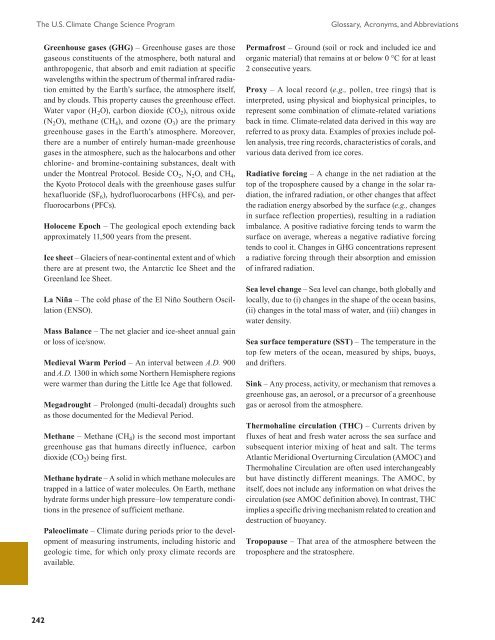Book 2.indb - US Climate Change Science Program
Book 2.indb - US Climate Change Science Program
Book 2.indb - US Climate Change Science Program
- No tags were found...
You also want an ePaper? Increase the reach of your titles
YUMPU automatically turns print PDFs into web optimized ePapers that Google loves.
The U.S. <strong>Climate</strong> <strong>Change</strong> <strong>Science</strong> <strong>Program</strong>Greenhouse gases (GHG) – Greenhouse gases are thosegaseous constituents of the atmosphere, both natural andanthropogenic, that absorb and emit radiation at specificwavelengths within the spectrum of thermal infrared radiationemitted by the Earth’s surface, the atmosphere itself,and by clouds. This property causes the greenhouse effect.Water vapor (H 2 O), carbon dioxide (CO 2 ), nitrous oxide(N 2 O), methane (CH 4 ), and ozone (O 3 ) are the primarygreenhouse gases in the Earth’s atmosphere. Moreover,there are a number of entirely human-made greenhousegases in the atmosphere, such as the halocarbons and otherchlorine- and bromine-containing substances, dealt withunder the Montreal Protocol. Beside CO 2 , N 2 O, and CH 4 ,the Kyoto Protocol deals with the greenhouse gases sulfurhexafluoride (SF 6 ), hydrofluorocarbons (HFCs), and perfluorocarbons(PFCs).Holocene Epoch – The geological epoch extending backapproximately 11,500 years from the present.Ice sheet – Glaciers of near-continental extent and of whichthere are at present two, the Antarctic Ice Sheet and theGreenland Ice Sheet.La Niña – The cold phase of the El Niño Southern Oscillation(ENSO).Mass Balance – The net glacier and ice-sheet annual gainor loss of ice/snow.Medieval Warm Period – An interval between A.D. 900and A.D. 1300 in which some Northern Hemisphere regionswere warmer than during the Little Ice Age that followed.Megadrought – Prolonged (multi-decadal) droughts suchas those documented for the Medieval Period.Methane – Methane (CH 4 ) is the second most importantgreenhouse gas that humans directly influence, carbondioxide (CO 2 ) being first.Methane hydrate – A solid in which methane molecules aretrapped in a lattice of water molecules. On Earth, methanehydrate forms under high pressure–low temperature conditionsin the presence of sufficient methane.Paleoclimate – <strong>Climate</strong> during periods prior to the developmentof measuring instruments, including historic andgeologic time, for which only proxy climate records areavailable.Glossary, Acronyms, and AbbreviationsPermafrost – Ground (soil or rock and included ice andorganic material) that remains at or below 0 °C for at least2 consecutive years.Proxy – A local record (e.g., pollen, tree rings) that isinterpreted, using physical and biophysical principles, torepresent some combination of climate-related variationsback in time. <strong>Climate</strong>-related data derived in this way arereferred to as proxy data. Examples of proxies include pollenanalysis, tree ring records, characteristics of corals, andvarious data derived from ice cores.Radiative forcing – A change in the net radiation at thetop of the troposphere caused by a change in the solar radiation,the infrared radiation, or other changes that affectthe radiation energy absorbed by the surface (e.g., changesin surface reflection properties), resulting in a radiationimbalance. A positive radiative forcing tends to warm thesurface on average, whereas a negative radiative forcingtends to cool it. <strong>Change</strong>s in GHG concentrations representa radiative forcing through their absorption and emissionof infrared radiation.Sea level change – Sea level can change, both globally andlocally, due to (i) changes in the shape of the ocean basins,(ii) changes in the total mass of water, and (iii) changes inwater density.Sea surface temperature (SST) – The temperature in thetop few meters of the ocean, measured by ships, buoys,and drifters.Sink – Any process, activity, or mechanism that removes agreenhouse gas, an aerosol, or a precursor of a greenhousegas or aerosol from the atmosphere.Thermohaline circulation (THC) – Currents driven byfluxes of heat and fresh water across the sea surface andsubsequent interior mixing of heat and salt. The termsAtlantic Meridional Overturning Circulation (AMOC) andThermohaline Circulation are often used interchangeablybut have distinctly different meanings. The AMOC, byitself, does not include any information on what drives thecirculation (see AMOC definition above). In contrast, THCimplies a specific driving mechanism related to creation anddestruction of buoyancy.Tropopause – That area of the atmosphere between thetroposphere and the stratosphere.242






